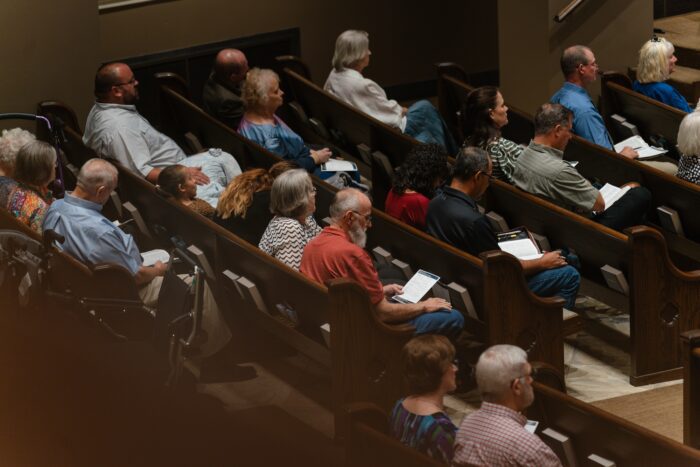Editor’s note: This year marks the centennial anniversaries of the Cooperative Program’s creation, the adoption of the Baptist Faith & Message, and the SBC’s ownership of Southwestern Seminary. To celebrate these 100 years of Southern Baptist cooperation, Southwestern has compiled eleven essays from key Southern Baptist leaders and seminary faculty for an original series on the ETC blog. The entire series, which will publish over the course of eleven weeks, will be available here. This essay is excerpted with permission from A Unity of Purpose: 100 Years of the SBC Cooperative Program, edited by Tony Wolfe and W. Madison Grace II. Copyright 2025, B&H Publishing.
During my tenure in Southern Baptist servant-leadership, I have heard the Cooperative Program explained countless times. Sometimes it is explained correctly, and sometimes incorrectly. Sometimes it is explained compellingly and sometimes stodgily. Often, it is expressed in terms of history or functionality. It has been explained and described. It has been storied and flowcharted. But explanations and descriptions notwithstanding, what is the Cooperative Program? What is it?
Defining the Cooperative Program
I offer the following definition as more concise and conclusive than other attempts to define it:
The Cooperative Program is a missions-funding mechanism involving the deliberate and voluntary cooperation of local Baptist churches, state/regional Baptist conventions, and the Southern Baptist Convention through which every contributing Baptist maximizes the Great Commission impact of every dollar given.
To define the thing is not only to name it, historize it, or explain it, but to demonstrate it in a way that is both accurate and compelling. Perhaps embracing the above definition will assist Southern Baptists in more comprehensively and more compellingly communicating the value of our unified budget program to our people for generations to come.
The Cooperative Program is a missions-funding mechanism …
God is on a mission. He is sovereignly working through the timeline of human history to redeem for himself a sanctified people. People from every nation and tongue who repent from sin and place their faith in Jesus Christ—those who are born again of the will of God (John 1:13)—are cleansed from sin and sealed by the Holy Spirit for the purpose of enjoying God’s glory with him forever in Heaven. God’s mission is to save his people from their sins and prepare them for Heaven. He has made ultimate provision for this mission through the life, death, burial, and resurrection of his son Jesus Christ. He has instituted his Church as the primary messenger and vehicle of his mission in our age, and he has invited every follower of Jesus to join him in this mission by plugging into and working through his Church. “Our mission,” Kevin DeYoung and Greg Gilbert explain, “is to go into the world and make disciples by declaring the gospel of Jesus Christ in the power of the Spirit and gathering these disciples into churches, that they might worship the Lord and obey his commands now and in eternity to the glory of God the Father.”1 Local churches find their place in God’s mission when they sacrificially invest themselves in gospel witness within their local communities and partner with likeminded churches to advance the gospel regionally, nationally, and internationally. The CP is, in its simplest form, a “plan of finance,”2 a strategic mechanism through which likeminded Baptist churches can accomplish their shared mission together with God regionally, nationally, and internationally.
It must be said, however, that God does not need our money. Perhaps a more accurate statement is that God already owns all our money. As he unfolds his mission in our time, God has in his possession and at his disposal “the earth and everything in it” (Psalm 24:1). Every dollar given through the CP is a practical expression of God channeling his own financial resources through the hands of faithfully sacrificial stewards. So, first and foremost, the CP is a practical invitation to find our place in God’s mission by sacrificially reinvesting his financial resources into his mission as a matter of faithful, biblical stewardship. It may be appropriate at this point to clarify, as others have through the years, that churches give through not to the CP.3 The CP is not an end in itself. It is a mechanism. A program. Machinery. The CP is a conduit for sacrificial giving through which local churches strategically invest in God’s mission. We give to God’s kingdom work; we give through the CP. The mechanism of the CP is a unified budget plan to unite the efforts of God’s people in God’s mission. So, the CP is a missions-funding mechanism.
The Cooperative Program is a missions-funding mechanism involving the deliberate and voluntary cooperation of local Baptist churches…
If the CP is predicated on missions-funding cooperation, then who are the agents of cooperation? Who are the cooperants? Individual Baptists give to God’s mission work through their local churches, but individual giving is not the CP. The missions-funding program of Southern Baptists is found in the voluntary financial interdependency of local Baptist churches. Baptist churches, each autonomous from the others, choose their own levels of participation with the larger work of Southern Baptists. Most regularly invested churches give between 5–10% of their undesignated receipts through the CP. Some give less. Some give as much as 15–20%. Each church decides its level of participation in the larger missions-funding program, and each can change its level of commitment whenever it chooses, for whatever reason.
Hildreth is wise to emphasize that the “Cooperative Program, even though it funds a global organization, is a local church program . . . The Cooperative Program is for, and by, the local church.”4 A local Baptist church’s participation in the CP is deliberate in that a church thoughtfully and methodically decides its own level of financial commitment. Encouragement toward the 10% mark has been considered a bit of a gold standard through the years. Initiatives for 1% more or extra end-of-year CP giving from churches have come periodically over the past one-hundred years. But when all is considered, each church determines its own level of participation. The deliberation belongs to each Baptist church. The program is, therefore, “for, and by, the local church.”
Financial cooperation is not only deliberate, but also voluntary. No denominational hierarchy exists to require churches to give through the CP. There are no annual dues or fees because there is no perpetual club of which churches can be a member. No Southern Baptist leader, entity, or sister church can command or force a church to participate. The CP is a voluntary interdependence between local churches. So, the success of the CP is dependent upon the degree to which local churches understand its value and participate in its mechanism. As Brand and Hankins once suggested, “the fundamental key to the success of the Cooperative Program and all Convention ministries is the local church.”5
Through the CP, local churches partner with one another in the ongoing Great Commission work of the Convention. They are not cooperating with entities, boards, committees, or leaders. The churches are cooperating with one another. In this way, the CP involves the deliberate and voluntary cooperation of local Baptist churches with one another. If churches refuse to financially partner together through this mechanism, they will have no CP.
The Cooperative Program is a missions-funding mechanism involving the deliberate and voluntary cooperation of local Baptist churches, state/regional Baptist conventions…
If the churches are pooling their funds through inter-congregational missions giving, who (or what) is the collection agency? Where do the churches send those funds in their unified missions-giving mechanism? The answer is state/regional conventions. Local Baptist churches pool their resources through the CP when they send a portion of their undesignated receipts to their state/regional Baptist convention. Since 1925, conventions of churches (by state or region) have been the collection agents for CP giving. Just as members of cooperating churches decide their church’s level of participation in the CP, messengers to each state/regional convention decide their convention’s allocation for state/regional and national distribution.
Autonomy is a Baptist hallmark at every level of cooperation, so state/regional conventions must decide what percentage of collected funds to keep for mission and ministry in their spheres of influence and what percentage to pass on through the Southern Baptist Convention for national and international mission work. Brand and Hankins explain, “The Cooperative Program is primarily a partnership between the Southern Baptist Convention and the various state conventions for serving Southern Baptist churches in their mission enterprises . . . a way for state conventions of Southern Baptists and the national Southern Baptist Convention to have a unified approach with the churches for funding missions.”6
In Better Together, Matz and Yeats champion this as “The best part of this plan” in that “it starts at home. Cooperative Program giving flows through our state and regional conventions . . . For congregations, this means our ability to support and uphold our work throughout the world starts right in our own backyards.”7 In 1925, eighteen state conventions participated in the CP. In 2024, that number was forty-one.
Just as the churches partner together in CP giving, it is the joy of their state/regional conventions also to partner with one another for the advancement of the gospel by allocating a percentage of undesignated receipts to the national and international causes of the Southern Baptist Convention. Through the CP mechanism, local Baptist churches support statewide and regional mission work to reach their neighbors and communities with the gospel while they also extend substantial financial resources through these state/regional conventions to fund the larger work of Southern Baptists.
The Cooperative Program is a missions-funding mechanism involving the deliberate and voluntary cooperation of local Baptist churches, state/regional Baptist conventions, and the Southern Baptist Convention…
The CP is unique to Southern Baptists. You will not find its equal in any other denominational structure or funding mechanism. The lynchpin is voluntary cooperation decided and governed by messengers from invested churches. Annually, messengers from invested churches gather to either reaffirm or redecide the allocation of funds toward their shared mission. Messengers to the annual Southern Baptist Convention have full control over the approval or amendment of the budget presented to them in annual session. In 2022, for example, messengers to the Southern Baptist Convention chose to allocate 50.41% of CP receipts to the IMB, 22.79% to NAMB, 21.92% to the six seminaries, 2.99% to the SBC operating budget, 1.65% to the ERLC, and 0.24% to the SBC Historic Library and Archives. Messengers’ participation in this budget approval, on behalf of their local Baptist churches, reflects a commitment to invest their financial resources in the missions-funding mechanism over the course of the next year. Throughout the year, CP funds are collected and distributed according to the allocation set by the messengers the previous year.
In the following pages, you will see centennial reports and celebrations from Southern Baptist entities which are funded through CP giving. Since 1925, Baptists have invested more than $20 billion in the ministries of these institutions through CP giving. Each of them, other than the state conventions and their entities, are distinctively Southern Baptist institutions; they belong to and are governed by their relationship to the Southern Baptist Convention. Lifeway Christian Resources and Guidestone Financial Services are also Southern Baptist institutions, but they do not receive direct funding through the CP. The Women’s Missionary Union is an auxiliary to the Southern Baptist Convention, working alongside Southern Baptists to raise awareness about, and additional funds for, our cooperative missional endeavors.
For one-hundred years, churches giving faithfully and sacrificially through the CP have funded our shared mission as Southern Baptists by making provision to evangelize communities, train and resource church leadership, plant churches, send missionaries, advocate for biblical values in the public square, and so much more. They have done so because they believe in and are sacrificially invested in their shared work as Southern Baptists. The mission belongs to God. The work belongs to the churches. The mechanism they have created and sustained for their cooperative engagement is distinctively Southern Baptist. The CP is the missions-funding mechanism of the Southern Baptist Convention.
The Cooperative Program is a missions-funding mechanism involving the deliberate and voluntary cooperation of local Baptist churches, state/regional Baptist conventions, and the Southern Baptist Convention through which every contributing Baptist maximizes the Great Commission impact of every dollar given.
“You will receive power when the Holy Spirit has come on you,” Jesus told his disciples the day of his ascension, “and you will be my witnesses in Jerusalem, in all Judea and Samaria, and to the ends of the earth” (Acts 1:8). If you are reading a book on the CP, there is likely nothing I could tell you about the “Great Commission” that you do not already know. In Matthew’s Gospel the same commission is bookended by the power and presence of Christ himself: “All authority has been given to me in heaven and on earth . . . I am with you always, to the end of the age” (Matthew 28:18–20). Christ commissions every born-again Christian to “Go and make disciples”—to “be my witnesses” locally, regionally, and globally. Our commission is great. Our time is short. “The Great Commission is for the whole church,” DeYoung and Gilbert emphasize, and that means you; “We go, we proclaim, we baptize, and we teach, all to the end of making lifelong, die-hard disciples of Jesus Christ who obey everything he commanded.”8 Through redemption in Jesus’s blood, every individual Christian has received the invitation and command of God to join him in his mission, under the guiding presence and commanding authority of Christ himself. We participate in God’s mission by fulfilling the Great Commission.
Ultimately, the CP begins right there, with individual Christ followers sold out for the Great Commission. United by essential Baptist doctrines and gathered in Baptist churches, they invest in Great Commission advance through their local churches and advocate for those churches to participate sacrificially in the shared missions-giving mechanism of the Convention. The CP starts here. It “originates with the undesignated gift of the individual Baptist to his church’s general budget.”9 Brand and Hankins emphasize that the ability of the CP to thrive is entirely predicated upon individual Baptists practicing biblical stewardship.10 Another has written, “The Cooperative Program begins with individuals and ends with ministries.”11
When the CP was born, budgeting was a fairly new concept for churches. Educating on and championing biblical financial stewardship for individuals and churches was as much of an “enlistment” activity by convention leaders as was CP enrollment.12 The CP thrives when individual Baptists give faithfully and sacrificially to God’s kingdom work through their local Baptist churches and those churches extend that faithful and sacrificial stewardship through the Convention’s missions-giving mechanism. Through the CP today, 14 million individual Baptists are funding the Great Commission. The program minimizes unnecessary duplication and financial waste, maximizing the effectiveness of every dollar given. Every dollar given through the CP extends gospel witness locally, regionally, nationally, and globally. The CP is not the only way to fund the larger Great Commission work, but since 1925 it has been, without equivocation, one of the most comprehensive and efficient. Through the CP, every contributing Baptist maximizes the Great Commission impact of every dollar given.
“Certainly the task ahead for Southern Baptists is greater, more meaningful and resultful than the task already accomplished,” Lee Rutland Scarborough, Director of the $75 Million Campaign, envisaged in faith while the heroic spirit of Southern Baptists began to form into a unified funding strategy for their shared Great Commission work. “We have merely begun in a more intensive and a more completely organized, co-operative way, our work of unifying, mobilizing, organizing, informing, instructing, enlisting, and marshalling our forces for the forward working of Christ’s Kingdom . . . Our program as mentioned above must have great, stirring, enthusiastic, and wisely-wrought-out plans for the future.”13 As the CP developed and enlarged, Scarborough saw his conceptual, unified missions-funding mechanism explode with Great Commission success. The program strengthened and gave new expression to the unity of purpose Southern Baptists had shared since their earliest days.
Perhaps one-hundred years and $20 billion later we too “have merely begun.” As we await the end of the age, we pour our lives out for the fulfillment of the Great Commission, together. We evangelize. We disciple. We equip. We train. We mobilize. We give. Baptists are a sacrificial people. To facilitate our sacrificial Great Commission cooperation, we have partnered in the gospel these past one-hundred years through the genius of the CP. But I believe the work ahead of us is even greater than the work behind us. I believe we have only just begun.
The CP is a missions-funding mechanism involving the deliberate and voluntary cooperation of local Baptist churches, state/regional Baptist conventions, and the Southern Baptist Convention through which every contributing Baptist maximizes the Great Commission impact of every dollar given. Hold it in your hands. Observe it. Examine it. Think about the hundreds of millions of souls across the globe who have heard the gospel of Jesus Christ because of Baptist churches working together in this missions-funding mechanism. And think of the billions more right now who stand in urgent need of the same. I invite you to put the CP to your own lips and share its beautiful music with the world. The CP is just an instrument. But in the right hands and on the right lips, it facilitates the advancement of the Great Commission in a biblical, exponential way. Look closely, and you’ll see.
- Kevin DeYoung and Greg Gilbert, What is the Mission of the Church? Making Sense of Social Justice, Shalom, and the Great Commission (Wheaton, IL: Crossway, 2011), 62. ↩︎
- W.W. Barnes, The Southern Baptist Convention 1845–1953 (Nashville: Broadman, 1954), 231. ↩︎
- Hildreth, Together on God’s Mission, 28. ↩︎
- Hildreth, Together on God’s Mission, 25–26. ↩︎
- Brand and Hankins, One Sacred Effort, 178. ↩︎
- Brand and Hankins, One Sacred Effort, 187–88. ↩︎
- Matz and Yeats, Better Together, 49. ↩︎
- DeYoung and Gilbert, What is the Mission of the Church?, 62–63. ↩︎
- Brand and Hankins, One Sacred Effort, 117. ↩︎
- Brand and Hankins, One Sacred Effort, 195–96. ↩︎
- Harper and Whitfield, SBC FAQs, 18. ↩︎
- Annual of the Southern Baptist Convention 1925, 36. In their first report, the Future Commission added, as part of its recommendations, “That there be a well co-ordinated (sic) program of teaching stewardship and promoting better financial methods in the churches, especially in assisting the churches to adopt the budget plan.” ↩︎
- Lee Rutland Scarborough, Marvels of Divine Leadership: Or, the Story of the Southern Baptist 75 Million Campaign (Nashville: Sunday School Board of the Southern Baptist Convention, 1920), 241. ↩︎









